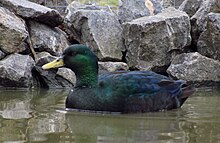The East Indie or Black East Indian is an ornamental breed of domestic duck. It is a bantam breed, and is thought to have originated in the United States.
 | |
| Conservation status | FAO (2007): endangered[1]: 141 |
|---|---|
| Other names |
|
| Country of origin | United States |
| Distribution | international |
| Use | ornamental |
| Traits | |
| Weight | |
| Classification | |
| APA | bantam duck[3]: 18 |
| EE | yes[4] |
| PCGB | bantam and call ducks[5] |
| |

History
editThe East Indie is the oldest breed of bantam duck.[6] It is thought to have originated in the United States, but its precise origin is not known.[7] It has at various times been known by other names, some of them – such as "Brazilian", "Buenos Airean", "Labrador" – suggesting a geographical origin. There is, however, no documented connection to the East Indies, to South America, or to Labrador.[8]: 38 [7] It is thought that the breed developed from its original form in the United Kingdom in the second half of the nineteenth century, and was then further refined in the United States in the latter part of the twentieth century.[8]: 38 A hypothesis that the black color of the plumage derives from the native American species Anas rubripes appears to be unsubstantiated.[8]: 38
Black East Indians were imported to the United Kingdom in or before 1831, supposedly from Buenos Aires, and were housed in the Zoological Gardens of the Zoological Society of London;[2]: 389 [9] they were at first called "Buenos Aireans".[10] Others were at Knowsley Hall, home of the Earls of Derby, in about 1850.[2]: 389 In 1853 the Black East Indian was described in the Poultry Book of William Wingfield and George William Johnson, with an illustration by Harrison Weir.[10][11]: 296 It was included in the original Standard of Excellence in Exhibition Poultry of William Bernhard Tegetmeier in 1865, and – as the Black Indie – in the first Standard of Perfection of the American Poultry Association in 1874.[8]: 38 [12]: 53
Characteristics
editThe East Indie is a bantam breed, usually weighing under 1 kg. It has very dark, lustrous greenish-black plumage and a black bill. Ducks may sometimes develop white feathers as they age;[5] drakes that do so should not be used for breeding. It flies well unless the wings are clipped. It is generally shyer and quieter than the Call Duck.[13]: 188
Use
editThe East Indie is largely kept by fanciers for exhibition or ornament. It may be helpful in pest control in gardens.[8]: 38
References
edit- ^ Barbara Rischkowsky, D. Pilling (eds.) (2007). List of breeds documented in the Global Databank for Animal Genetic Resources, annex to The State of the World's Animal Genetic Resources for Food and Agriculture. Rome: Food and Agriculture Organization of the United Nations. ISBN 9789251057629. Accessed January 2017.
- ^ a b c d e Victoria Roberts (2008). British poultry standards: complete specifications and judging points of all standardized breeds and varieties of poultry as compiled by the specialist breed clubs and recognised by the Poultry Club of Great Britain. Oxford: Blackwell. ISBN 9781405156424.
- ^ APA Recognized Breeds and Varieties: As of January 1, 2012. American Poultry Association. Archived 4 November 2017.
- ^ Liste des races et variétés homologuée dans les pays EE (28.04.2013). Entente Européenne d’Aviculture et de Cuniculture. Archived 16 June 2013.
- ^ a b Breed Classification. Poultry Club of Great Britain. Archived 12 June 2018.
- ^ Bantam ducks. British Waterfowl Association. Accessed September 2017.
- ^ a b Black East Indian. Rare Breeds Survival Trust. Accessed September 2017.
- ^ a b c d e Dave Holderread (2011). Storey's Guide to Raising Ducks, second edition. North Adams, Massachusetts: Storey Publishing. ISBN 9781603427456.
- ^ Ducks. Poultry Club of Great Britain. Archived 9 November 2018.
- ^ a b Chris Ashton, Mike Ashton (2001). The Domestic Duck. Ramsbury, Marlborough: The Crowood Press. ISBN 9781847979704.
- ^ William Wingfield, George William Johnson, Harrison Weir (illustrator) (1853). The Poultry Book: comprising the characteristics, management, breeding and medical treatment of Poultry. London: Wm. S. Orr and Co.
- ^ William Bernhard Tegetmeier (editor). The Standard of Excellence in Exhibition Poultry, authorized by the Poultry Club. London: Groombridge and Sons, for the Poultry Club, 1865.
- ^ Carol Ekarius (2007). Storey's Illustrated Guide to Poultry Breeds. North Adams, Massachusetts: Storey Publishing. ISBN 9781580176675.